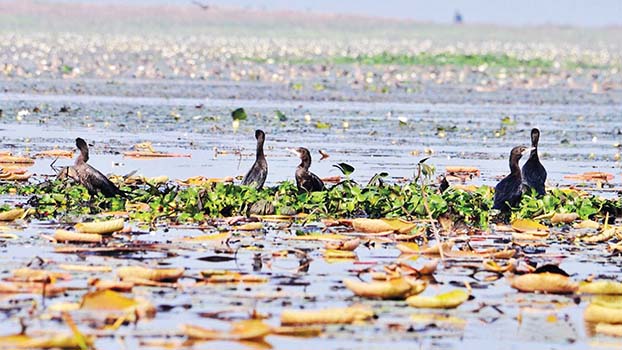Baikka Beel buzzes with migratory birds

As winter approaches, Baikka Beel is bustling with migratory birds. In the beginning of winter different kinds of storks, eagles, ducks and colourful birds flock to the wetlands.
It is primarily a breeding ground for indigenous species of fish and a place of safety for fisheries. One hundred hectares in size, Baikka Beel is one of the country's most preserved rich natural wetlands.
Like every year, this year the birds from cold continents have started to fly in to the famous wetland of Sylhet.
Domestic and foreign tourists come from far away to enjoy the scenery while floating in the water or sitting quietly on the boat.
From the snowy countries of the Northern Hemisphere of the world, some species of birds return to different wetland rich countries of Asia.
Bangladesh is one such country in Asia. That is why many mature birds come here every year. After staying for a few months, they go back to their prior habitation.
Founder and renowned bird researcher at the Bird Club of Bangladesh, author Inam al-Haq said, ‘Feeding birds in Baikka Beel has begun. Already, I have seen a few species. These are the Common Teal, the Piang Duck (Gadwall), the Great Cormorant, and the Glossy Ibis. The highest amount of birds I saw were the ducks. ‘
‘Glossy Ibis has come a long way. On one jump, I counted 36, on the other, I saw 17. They disappeared from Bangladesh earlier. Over a year ago, we got the first Glossy Ibis in Tanguar Haor in Bangladesh. Then the number of them gradually increased.’
Over a hundred of them were also found last year at Baikka Beel. This time, 53 Glossy Ibis have already arrived; I am hoping that the number will increase even more from last year.
Referring to the beach birds, the researcher said that several beach birds have arrived. They could not be identified precisely because they were far away.
Regarding the local birds of the beel, Inam al-Haq said, ‘I saw a lot of Cotton Pygmy-goose; they were feeding. These ducks are residents of Baikka Beel.
Osprey, Greater Spotted Eagle, Gray-headed Lapwing, Wood Sandpiper, Green Sandpiper, Temmincks Stint, Meteorite (Gray Wagtail), Yellow Wagtail, White Wagtail remain in Baikka Beel all day’, he added.
The nature of these birds, which were seen during the winter season, fascinated him, he said.
Baikka Beel Sanctuary is to protect and restore aquatic biodiversity (particularly fish and birds) in Hail Haor.
A secondary aim is to enhance enjoyment of the site and understanding of nature, the value of wetlands and need for their conservation through the visitor facilities. The sanctuary and its facilities are a model that can encourage replication of similar sanctuaries elsewhere in the country.
Baikka Beel is a 100 hectares wetland sanctuary located in Hail Haor, a large wetland seasonally extending from 3,000-12,000 hectares, in north-east Bangladesh.
Baikka Beel comprises of open water with emergent vegetation (mostly lotus), and a fringe of native swamp forest planted 5 to 8 years ago. Originally it was made to conserve and restore fish and it supports about 90 species of fish, but populations of winter water birds rapidly increased.
So far 141 bird species have been recorded in the sanctuary. Mammals are few but include the Fishing Cat.
A visitor tower with several permanent interpretive displays was opened in early 2007. This is the only such facility in the country and this is the only substantial community managed wetland sanctuary in the country.
There are plans to construct a visitor centre and other facilities with funds left over from the earlierManagement of Aquatic Ecosystems through Community Husbandry (MACH) project.
Visitor number have not been recorded as reliably as would be ideal, but are in the low thousands per year and include student groups, diverse government officials, and a wide range of foreign visitors.




